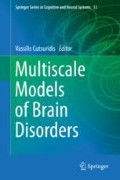Abstract
Genetic and pharmacological evidence implicates N-methyl-D-aspartate receptor (NMDAR) dysfunction in the pathophysiology of schizophrenia. Dysfunction of this key receptor – if localised to inhibitory interneurons – could cause a net disinhibition of cortex and increase in ‘noise’. These effects can be computationally modelled in a variety of ways: by reducing the precision in Bayesian models of behaviour, by estimating neuronal excitability changes in schizophrenia from evoked responses, or – as described in detail here – by modelling abnormal belief updating in a probabilistic inference task. Features of belief updating in schizophrenia include greater updating to unexpected evidence, lower updating to consistent evidence, and greater stochasticity in responding. All of these features can be explained by a loss of stability of ‘attractor states’ in cortex and the representations they encode. Indeed, a hierarchical Bayesian model of belief updating indicates that subjects with schizophrenia have a consistently increased ‘belief instability’ parameter. This instability could be a direct result of cortical disinhibition: this hypothesis should be explored in future studies.
Access this chapter
Tax calculation will be finalised at checkout
Purchases are for personal use only
References
Harrison PJ (2015) Recent genetic findings in schizophrenia and their therapeutic relevance. J Psychopharmacol Oxf Engl 29:85–96
Javitt DC, Zukin SR, Heresco-Levy U, Umbricht D (2012) Has an angel shown the way? Etiological and therapeutic implications of the PCP/NMDA model of schizophrenia. Schizophr Bull 38:958–966
Paoletti P, Bellone C, Zhou Q (2013) NMDA receptor subunit diversity: impact on receptor properties, synaptic plasticity and disease. Nat Rev Neurosci 14:383–400
Weickert CS et al (2012) Molecular evidence of N-methyl-D-aspartate receptor hypofunction in schizophrenia. Mol Psychiatry. https://doi.org/10.1038/mp.2012.137
Adams RA, Stephan KE, Brown HR, Frith CD, Friston KJ (2013) The computational anatomy of psychosis. Front Psychiatry 4:47
Umbricht D, Krljes S (2005) Mismatch negativity in schizophrenia: a meta-analysis. Schizophr Res 76:1–23
Ranlund S et al (2016) Impaired prefrontal synaptic gain in people with psychosis and their relatives during the mismatch negativity. Hum Brain Mapp 37:351–365
Yang GJ et al (2014) Altered global brain signal in schizophrenia. Proc Natl Acad Sci U S A 111:7438–7443
Yang GJ et al (2016) Functional hierarchy underlies preferential connectivity disturbances in schizophrenia. Proc Natl Acad Sci U S A 113:E219–E228
Murray JD et al (2014) Linking microcircuit dysfunction to cognitive impairment: effects of disinhibition associated with schizophrenia in a cortical working memory model. Cereb Cortex N Y N 1991 24:859–872
Mayer JS, Park S (2012) Working memory encoding and false memory in schizophrenia and bipolar disorder in a spatial delayed response task. J Abnorm Psychol 121:784–794
Hopfield JJ (1982) Neural networks and physical systems with emergent collective computational abilities. Proc Natl Acad Sci U S A 79:2554–2558
Wang X-J (2013) The prefrontal cortex as a quintessential ‘cognitive-type’ neural circuit: working memory and decision making
Gepperth A, Lefort M (2016) Learning to be attractive: probabilistic computation with dynamic attractor networks. In: 2016 joint IEEE international conference on development and learning and epigenetic robotics (ICDL-EpiRob). p 270–277. https://doi.org/10.1109/DEVLRN.2016.7846831
Rolls ET, Loh M, Deco G, Winterer G (2008) Computational models of schizophrenia and dopamine modulation in the prefrontal cortex. Nat Rev Neurosci 9:696–709
Hamm JP, Peterka DS, Gogos JA, Yuste R (2017) Altered cortical ensembles in mouse models of schizophrenia. Neuron 94:153–167.e8
Vinckier F et al (2016) Confidence and psychosis: a neuro-computational account of contingency learning disruption by NMDA blockade. Mol Psychiatry 21:946–955
Garety PA, Hemsley DR, Wessely S (1991) Reasoning in deluded schizophrenic and paranoid patients. Biases in performance on a probabilistic inference task. J Nerv Ment Dis 179:194–201
Dudley R, Taylor P, Wickham S, Hutton P (2016) Psychosis, delusions and the ‘Jumping to Conclusions’ reasoning bias: a systematic review and meta-analysis. Schizophr Bull 42:652–665
Langdon R, Ward PB, Coltheart M (2010) Reasoning anomalies associated with delusions in schizophrenia. Schizophr Bull 36:321–330
Fear CF, Healy D (1997) Probabilistic reasoning in obsessive-compulsive and delusional disorders. Psychol Med 27:199–208
Young HF, Bentall RP (1997) Probabilistic reasoning in deluded, depressed and normal subjects: effects of task difficulty and meaningful versus non-meaningful material. Psychol Med 27:455–465
Peters E, Garety P (2006) Cognitive functioning in delusions: a longitudinal analysis. Behav Res Ther 44:481–514
Averbeck BB, Evans S, Chouhan V, Bristow E, Shergill SS (2010) Probabilistic learning and inference in schizophrenia. Schizophr Res. https://doi.org/10.1016/j.schres.2010.08.009
Moutoussis M, Bentall RP, El-Deredy W, Dayan P (2011) Bayesian modelling of Jumping-to-Conclusions bias in delusional patients. Cogn Neuropsychiatry 16:422–447
Schlagenhauf F et al (2013) Striatal dysfunction during reversal learning in unmedicated schizophrenia patients. NeuroImage. https://doi.org/10.1016/j.neuroimage.2013.11.034
Adams RA, Napier G, Roiser JP, Mathys C, Gilleen J (2018) Attractor-like dynamics in belief updating in schizophrenia. J Neurosci 38:9471–9485
Mathys C, Daunizeau J, Friston KJ, Stephan KE (2011) A Bayesian foundation for individual learning under uncertainty. Front Hum Neurosci 5:39
Jardri R, Duverne S, Litvinova AS, Denève S (2017) Experimental evidence for circular inference in schizophrenia. Nat Commun 8:14218
Stuke H, Stuke H, Weilnhammer VA, Schmack K (2017) Psychotic experiences and overhasty inferences are related to maladaptive learning. PLoS Comput Biol 13:e1005328
Author information
Authors and Affiliations
Corresponding author
Editor information
Editors and Affiliations
Rights and permissions
Copyright information
© 2019 Springer Nature Switzerland AG
About this chapter
Cite this chapter
Adams, R.A. (2019). Cortical Disinhibition, Attractor Dynamics, and Belief Updating in Schizophrenia. In: Cutsuridis, V. (eds) Multiscale Models of Brain Disorders. Springer Series in Cognitive and Neural Systems, vol 13. Springer, Cham. https://doi.org/10.1007/978-3-030-18830-6_8
Download citation
DOI: https://doi.org/10.1007/978-3-030-18830-6_8
Published:
Publisher Name: Springer, Cham
Print ISBN: 978-3-030-18829-0
Online ISBN: 978-3-030-18830-6
eBook Packages: Biomedical and Life SciencesBiomedical and Life Sciences (R0)

